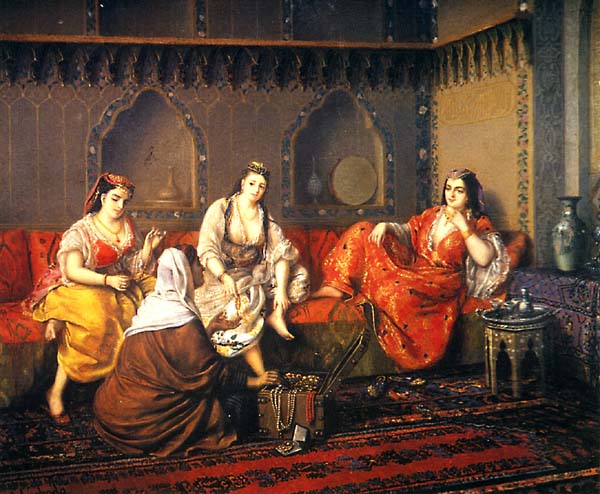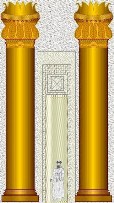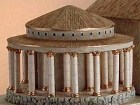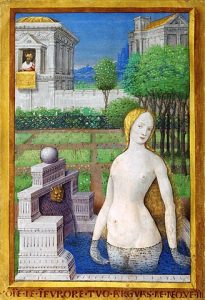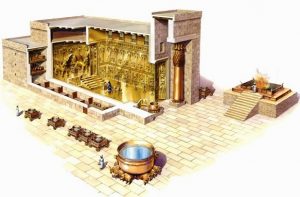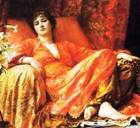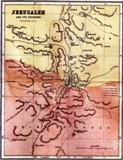The Harem in Solomon’s palace
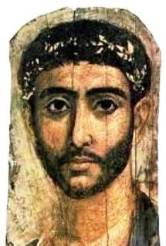 Solomon’s wives were housed in their own separate quarters – the harem. It was a no-go zone for any males other than the king.
Solomon’s wives were housed in their own separate quarters – the harem. It was a no-go zone for any males other than the king.
Naturally, women of higher rank and greater wealth got the best quarters.
But all the wives and concubines lived together, and no doubt there were loving friends and bitter rivals among the women of the harem.
Who was Queen?
The most important woman in the harem was the Queen Mother, mother of the reigning king. She was called the Gebira.
There was no Queen, since the reigning king had many wives and favorites, all of whom had to pay their respects to the mother of the king.
In Solomon’s harem, for example, Bathsheba was Queen Mother.
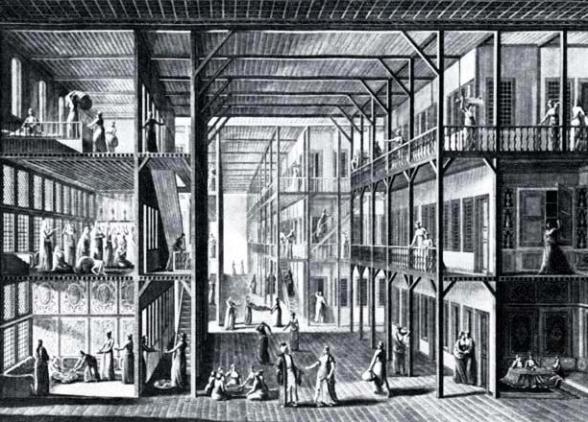
Drawing of the 18th-19th century Turkish harem in Istanbul.
The women’s quarters in Solomon’s palace were probably similar.
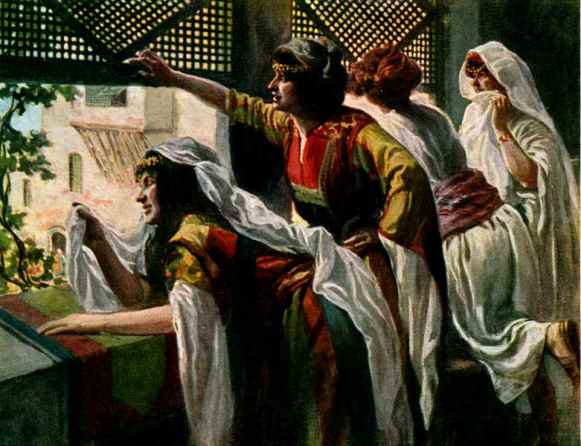
19th century painting of Middle Eastern women looking through the lattice on the windows of their harem; royal women were strictly secluded from the outside world
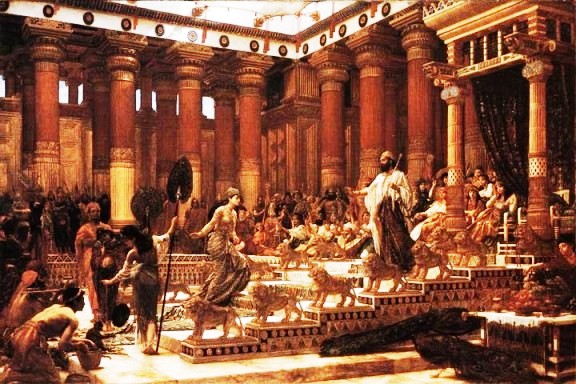
Visit of the Queen of Sheba to King Solomon’s Court, Sir Edward Poynter
What was the harem like?
King Solomon is supposed to have been fond of women, so fond that he had one thousand wives and concubines.
It is unlikely he had as many as this: ‘one thousand’ was meant to tell the Bible reader that Solomon
- loved women’s company
- had the virility to cope with many wives
- had the financial resources to support 1,000 women and their children.
You would think, then, that paintings of Solomon would show at least some of his many wives and children.
But no. Instead, 19th century artists seem to have overlooked the multitude of wives, and concentrated instead on the luxurious buildings described in the Bible account.
At that time modern archaeology had hardly begun, so artists had very little to go on. This did not stop them. They let their imaginations run wild, painting David and Solomon in the most unlikely settings. These were lavish – much more so than the real Solomon had, and the architecture was a sort of bastardised Greek rather than ancient Middle Eastern.
You can see an example of this in the architectural detail in Sir Lawrence Tadema’s ‘Visit of the Queen of Sheba to King Solomon’ above.
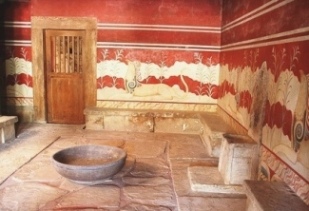
The Throne Room at Knossos (above) may have been similar in size and layout to the one in Solomon’s palace
In fact, the throne/judgement room in Solomon’s palace was probably much more modest, something like the throne room excavated at Knossos (see right). The palace at Knossos was built hundreds of years before Solomon’s palace, but came out of a much richer mini-empire.
The Reality
The royal palace of Solomon took twice as long to build as the Temple, and was much more complicated. In fact, it was a whole complex of buildings, with many different functions. According to the Bible, our only souce of information, there was:
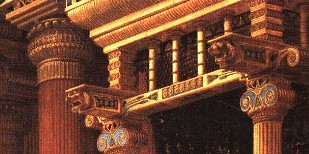 the cedar-pillared House of the Forest of Lebanon, perhaps an audience hall
the cedar-pillared House of the Forest of Lebanon, perhaps an audience hall- a treasury or strongroom
- the Judgement Hall where Solomon’s magnificent ivory throne stood
- a special palace for the daughter of Pharaoh, Solomon’s most high-born wife
- living quarters for Solomon’s multitude of wives and children. Though the ‘thousand wives of Solomon’ is probably an exaggeration, there were certainly a lot of them. Solomon cemented alliances with neighbouring territories by marrying their rulers’ daughters, and by giving his own daughters in marriage to governors of provinces (see the stories of Basemath and Taphath).
The reconstruction of Xerxes’ palace (below) at Persepolis gives some idea of the lay-out of palace complexes. They were not simply great houses where the king lived, but administrative centers for the surrounding territory.
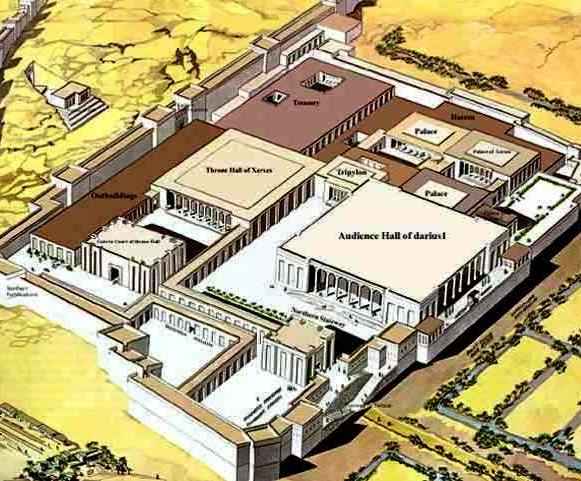
Solomon’s palace would have been something like this,
but on a smaller scale.
Space was not the problem: see the area available to Solomon on the map below.
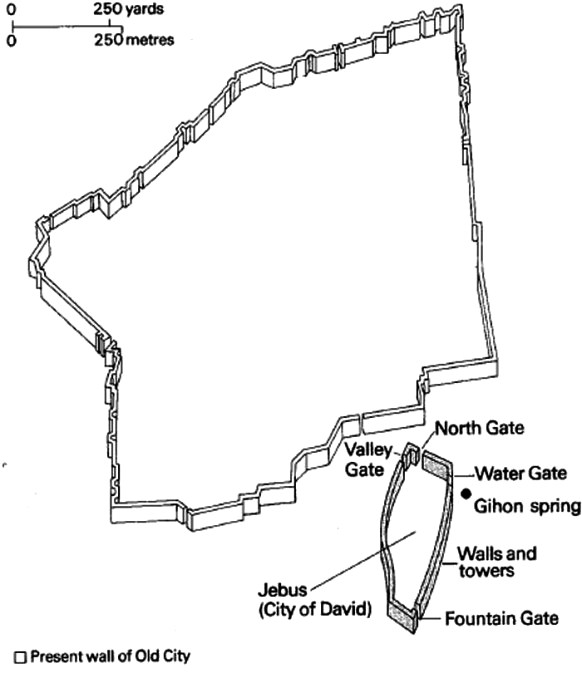
Jerusalem was originally a small fortress perched on top of a ridge just south of a flat rocky surface (Jebus, bottom right). Solomon built his palace and Temple on the large enclosed area to its north – the Temple Mount.
Bible Study Resource for Women in the Bible
King Solomon’s palace in Jerusalem
‘Solomon’ links
Palaces in the Bible
Solomon’s Palace, the Ivory House at Samaria, Persepolis, King Herod’s Masada
Search the Site
© Copyright 2006
Elizabeth Fletcher

